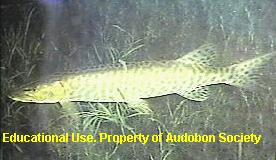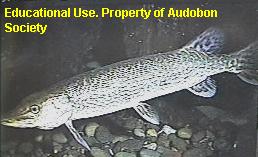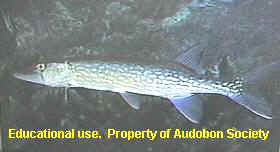WELCOME TO OPEFE ARCHIVES
Pikes
and Pickerel
(family Esocidae)
INTRODUCTION
Pikes and pickerels comprise
5 species in North America. All possess sharp teeth, elongated body
semi-compressed and a flattened snout. The dorsal and anal fins are located
opposite each other far back on the body, and the caudal fin is forked.
Muskellunge
Esox
Masquinongy
 Growing to 6 feet and weighing 100 lbs this fish is
found in lakes, reservoirs with thick vegetation, slow meandering rivers and
streams with abundant plant cover. Valued as a prize by anglers this voracious
fish feeds primarily on fishes, but will eat any animal it can swallow, such as
small ducks and amphibians. The species has been cross bred with the Northern
pike producing a hybrid called the Tiger Muskellunge, a much more robust
species. They prefer temperature between 67░ F to 72░ F, though they have been
known to tolerate up to 80░ F. Muskellunge do not thrive in same populations
with Northern Pike. Northern Pike hatch earlier and make a meal of the
muskellunge fry. Food requirements are similar to the Northern Pike. The primary
diet though is fish.
Growing to 6 feet and weighing 100 lbs this fish is
found in lakes, reservoirs with thick vegetation, slow meandering rivers and
streams with abundant plant cover. Valued as a prize by anglers this voracious
fish feeds primarily on fishes, but will eat any animal it can swallow, such as
small ducks and amphibians. The species has been cross bred with the Northern
pike producing a hybrid called the Tiger Muskellunge, a much more robust
species. They prefer temperature between 67░ F to 72░ F, though they have been
known to tolerate up to 80░ F. Muskellunge do not thrive in same populations
with Northern Pike. Northern Pike hatch earlier and make a meal of the
muskellunge fry. Food requirements are similar to the Northern Pike. The primary
diet though is fish.
Northern
Pike
Esox
lucius
 Growing to just a little over 4 feet
and weighing about 46 lbs this fish is like the preceding is found in lakes,
reservoirs, and large streams with little current and abundant vegetation. The
species is the most wide-spread freshwater fish in the world. Once considered a
commercial fish it is mostly now a sports fish with little economic value. In
California, a few years ago Northern Pike was found in a lake and the regulatory
agency there used rotenone (a chemical that attacks the gills of fish) to poison
the fish. Instead the chemical was allegedly mishandled and it spilled 5 miles
down a creek killing all the native fishes except the pike which was later found
still inhabiting the lake. Their diet consists of frogs, crayfish, mice,
muskrats, and ducklings. The fish prefers large items to fill its stomach rather
than small ones.
Growing to just a little over 4 feet
and weighing about 46 lbs this fish is like the preceding is found in lakes,
reservoirs, and large streams with little current and abundant vegetation. The
species is the most wide-spread freshwater fish in the world. Once considered a
commercial fish it is mostly now a sports fish with little economic value. In
California, a few years ago Northern Pike was found in a lake and the regulatory
agency there used rotenone (a chemical that attacks the gills of fish) to poison
the fish. Instead the chemical was allegedly mishandled and it spilled 5 miles
down a creek killing all the native fishes except the pike which was later found
still inhabiting the lake. Their diet consists of frogs, crayfish, mice,
muskrats, and ducklings. The fish prefers large items to fill its stomach rather
than small ones.
Chain
Pickerel
Esox
niger
 Growing to 3 feet, weighing a
little over 9 pounds, these fish are found in clean, clear lakes, ponds, swamps,
reservoirs, and pools of streams with vegetation. These are considered an
important sports fish in the northeastern United States. However, the fish was
erroneously spread by the regulatory agency when they misidentified this species
for Northern Pike. This mistake in identification caused widespread damage to
native populations since this species reproduces rapidly. On other smaller
species is called the red-finned pickerel. They prefer water temperature of 75░
F to 80░ F. Their diet consists of insects, frogs, mice, crayfish, and a wide
variety of other foods. They have been known to hybridize with red-finned and
northern pike.The species are not suitable for the home aquarium. However, there
are some exceptions as noted above. They are constant feeders and even one pike
would require quite a few "live" fish to keep it from dying of
malnutrition. Many states now prohibit its importation or transplantation
because it is so prolific. Historically, this species has inspired many
"fish stories" including biting humans that were swimming or small
dogs being eaten. Other stories abound regarding the fishes size, one famous
account having to do with several parts of a muskellunge being sewed together to
create one giant size "monster" fish. However, many of the other
stories are true.
Growing to 3 feet, weighing a
little over 9 pounds, these fish are found in clean, clear lakes, ponds, swamps,
reservoirs, and pools of streams with vegetation. These are considered an
important sports fish in the northeastern United States. However, the fish was
erroneously spread by the regulatory agency when they misidentified this species
for Northern Pike. This mistake in identification caused widespread damage to
native populations since this species reproduces rapidly. On other smaller
species is called the red-finned pickerel. They prefer water temperature of 75░
F to 80░ F. Their diet consists of insects, frogs, mice, crayfish, and a wide
variety of other foods. They have been known to hybridize with red-finned and
northern pike.The species are not suitable for the home aquarium. However, there
are some exceptions as noted above. They are constant feeders and even one pike
would require quite a few "live" fish to keep it from dying of
malnutrition. Many states now prohibit its importation or transplantation
because it is so prolific. Historically, this species has inspired many
"fish stories" including biting humans that were swimming or small
dogs being eaten. Other stories abound regarding the fishes size, one famous
account having to do with several parts of a muskellunge being sewed together to
create one giant size "monster" fish. However, many of the other
stories are true.
The
fish uses its ability to contort its body into a "Z" and spring
forward at amazing speed to attack an unsuspecting prey. They are egg scatters
in shallow areas and then abandon them. At about three to four weeks after
hatching, they begin to cannibalize other fry. Because of the large size of
their mouths, they are able to ingest fishes twice their size. It is a well
known fact that fishermen use steel leaders when fishing for these fish since
monofilament is easily cut by the fishes sharp teeth. Even 20-30 lb
monofilament!
REFERENCES
-
National
Audobon Society, Fishes Whales & Dolphins, 1995, Borzoi Book, Alfred A.
Knoph, Inc.
-
Dick
Sternberg, 1987, Freshwater Game Fish, The Hunting and Fishing Library
USE YOUR BACKSPACE OR CLICK HERE TO RETURN
OTHER PREDATORY FISH
USE THIS LINK TO RETURN TO
RESEARCH PAGE
TO
RETURN HOME CLICK HERE
The OPEFE web site and its contents; is disclaimed for purposes of
Zoological Nomenclature in accordance with the International Code of Zoological
Nomenclature, Fourth Edition, Article 8.3 and 8.4. No new names or nomenclature
changes are available from statements at this web site.
Copyrightę 1994-2012 Oregon Piranha Exotic Fish Exhibit (The OPEFE
fish exhibit is permanently CLOSED as of 2000) Sutherlin, Oregon. Information
posted on this web site is archival data on fish scientific classifications and
other information. DISCLAIMER: The copyrighted material may not be used
for any purpose other than private study, scholarship or research. Cited
information requires credit and this link www.opefe.com. All rights reserved.
All images shown (unless otherwise noted) is property of OPEFE.

 Growing to 6 feet and weighing 100 lbs this fish is
found in lakes, reservoirs with thick vegetation, slow meandering rivers and
streams with abundant plant cover. Valued as a prize by anglers this voracious
fish feeds primarily on fishes, but will eat any animal it can swallow, such as
small ducks and amphibians. The species has been cross bred with the Northern
pike producing a hybrid called the Tiger Muskellunge, a much more robust
species. They prefer temperature between 67░ F to 72░ F, though they have been
known to tolerate up to 80░ F. Muskellunge do not thrive in same populations
with Northern Pike. Northern Pike hatch earlier and make a meal of the
muskellunge fry. Food requirements are similar to the Northern Pike. The primary
diet though is fish.
Growing to 6 feet and weighing 100 lbs this fish is
found in lakes, reservoirs with thick vegetation, slow meandering rivers and
streams with abundant plant cover. Valued as a prize by anglers this voracious
fish feeds primarily on fishes, but will eat any animal it can swallow, such as
small ducks and amphibians. The species has been cross bred with the Northern
pike producing a hybrid called the Tiger Muskellunge, a much more robust
species. They prefer temperature between 67░ F to 72░ F, though they have been
known to tolerate up to 80░ F. Muskellunge do not thrive in same populations
with Northern Pike. Northern Pike hatch earlier and make a meal of the
muskellunge fry. Food requirements are similar to the Northern Pike. The primary
diet though is fish.
